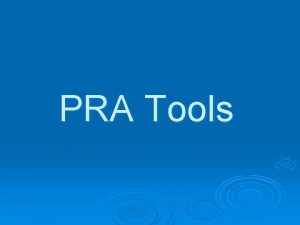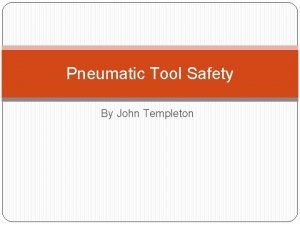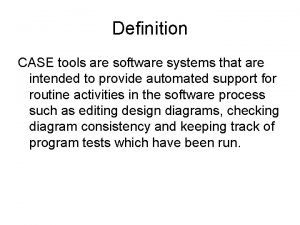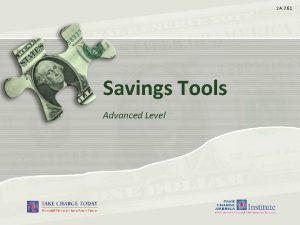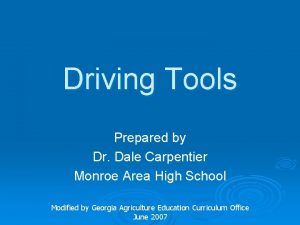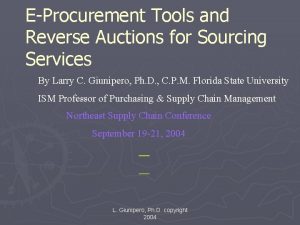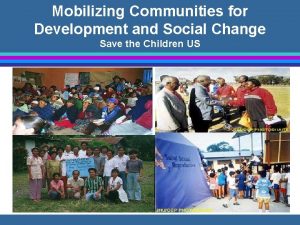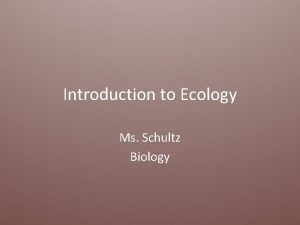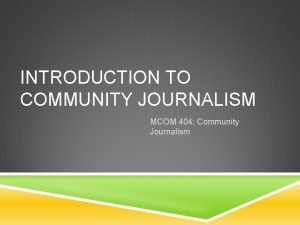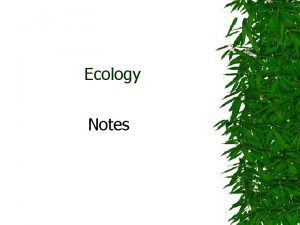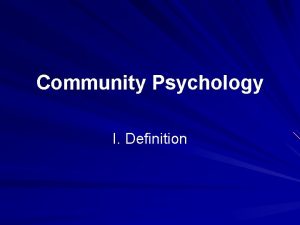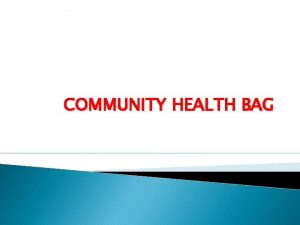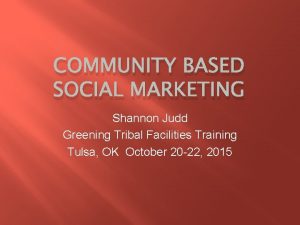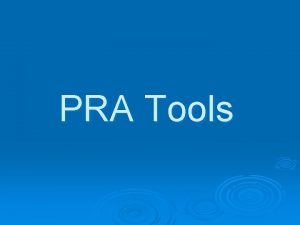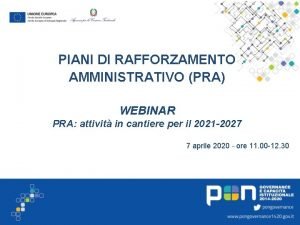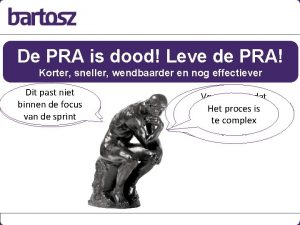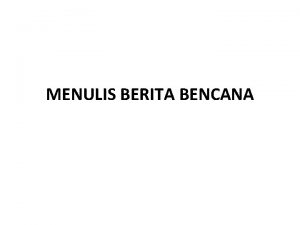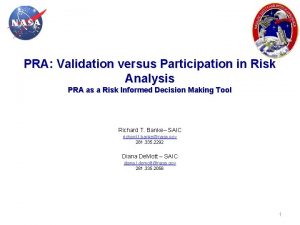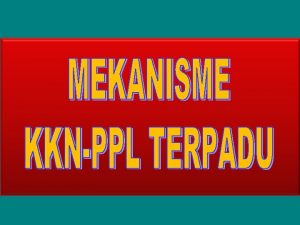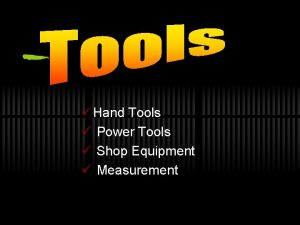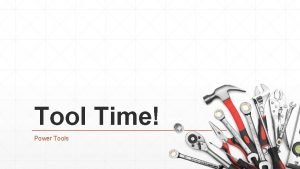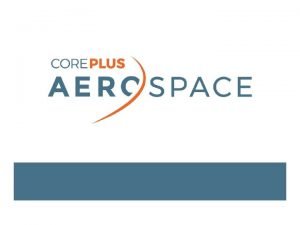PRA Tools PRA definition PRA is a community


















- Slides: 18

PRA Tools

PRA definition PRA is a community development approach that attempts to empower whole communities to define their own strategies and actions within the limits of their skills, strengths, and resources in order to realize sustainable development.

What is PRA? PRA is intended to enable local communities to conduct their own analysis and plan and take action. (Chambers R. 1992)

Definition-1 Ø A growing family of Approaches, methods, Attitudes and Behaviors to enable and empower people to share, analyze and enhance their knowledge of life and conditions, and to plan, act, monitor, evaluate and reflect

Definition-2 Ø Participatory rural appraisal (PRA) is a label given to a growing family of participatory approaches and methods that emphasize local knowledge and enable local people to make their own appraisal, analysis, and plans.

Definition 3 Ø PRA is a community development approach that attempts to empower whole communities to define their own strategies and actions within the limits of their skills, strengths, and resources in order to realize sustainable development.

PRA limitations Multi-disciplinarily and collaboration: although emphasized by PRA, both multi-disciplinary and interagency collaboration are hard to achieve to a meaningful scale. Ø PRA team preparedness: Development agencies (or PRA teams) are rarely fully prepared and equipped with the PRA philosophy, principles, tools and process. Ø Financial support: There is no doubt that PRA can be an expensive exercise, financially. Many times there are not enough funds to drive the PRA exercise in the desired and most effective manner. Ø

Time frame: PRA (being an exit strategy-oriented, community development approach) is mostly limited by time. Community insiders and outsiders require an ample amount of time to interact and build trust and understanding in order to generate useful information to drive the PRA process in the desired direction. Ø Community barriers: Language and cultural difference can be a major constraint in the interaction of outsiders and insiders throughout the PRA process. Ø Community, socio-economics/education: The general socio-economic and/or education standing of the target community greatly influences the outcome of the PRA process. Communities living in abject poverty or those with little formal education may present a great challenge to the implementers of the PRA process. Ø

Community infrastructure: The roads and communication network within a given community can present a challenge that could be limiting. Ø Community harmony: Communities that are rife with clan, ethnic or sectoral differences areas generally challenging and limiting to the PRA process. Ø General security: Communities laden with insecurities are generally hard to work with. Ø

PRA Assumptions PRA is an ideal and effective approach in community development only if it assumes the following: Ø Critical awareness and understanding of the PRA principles, tools, process and ethics by the PRA team or development agency Ø Multidisciplinary yet homogenous PRA team Ø Immunity from all possible limitations

Ø Ø That the PRA process is socially acceptable, economically viable and ecologically sound A wealth of untapped, unorganized and under-utilized information and resources lie within the target community Inherent local/community leadership is available to spearhead community development issues Definite community needs and priorities form the basis of attracting outside help

Procedures in Conducting PRA Development staff involves in: Step 1: Preparation of material Ø Step 2: Briefing villagers about PRA Ø Step 3: Discussing criteria for organizing a PRA team Ø Step 4: Discussing procedures, requirement and expected outcome Ø Step 5: Planning and preparation for PRA Ø

Procedures in Conducting PRA Ø Step 6: Undertaking of PRA exercise Ø Step 7: Reviewing the processes and output of PRA Ø Step 8: Reporting of PRA results to the villagers

PRA TOOLS There are variety of methods that are used during PRA exercise in order to elicit community participation in the generation of information. These methods can be classified into three broad categories.

Ø Visualized Analysis Ø Interviewing and sampling Ø Group and team dynamics These methods can be used singularly one at time or in a combination of two to three, all the three are combined for best results.

Visualized Analysis A. Ø Ø Participatory mapping and modeling like Resource maps Social maps of residential areas of villages Topical maps e. g. collection sites for water points, soils etc Impact monitoring map e. g. pest attack, soil erosion, deforestation etc.

B. Participatory Diagramming Trend Lines Show quantitative changes over time and can be used for many variables such as: Yields, area under cultivation, livestock population, prices, rainfall etc.

C. Discussion and Brain storming like Semi Structured Interviews creates discussions among the participants to get their point of view.
 Pra is
Pra is Pra in community development
Pra in community development Marking tools in sewing
Marking tools in sewing Prepare to scale up in community mobilization
Prepare to scale up in community mobilization Pneumatic tools safety
Pneumatic tools safety Case tools definition
Case tools definition Savings tools definition
Savings tools definition Cutting tools technology
Cutting tools technology Definition of driving tools
Definition of driving tools Reverse auction tools
Reverse auction tools Community mobilization in education
Community mobilization in education What is a community in biology
What is a community in biology Community journalism
Community journalism Community definition biology
Community definition biology Community psychology definition
Community psychology definition Define active community participation
Define active community participation Compartment of community bag
Compartment of community bag Community development define
Community development define Shannon judd
Shannon judd
